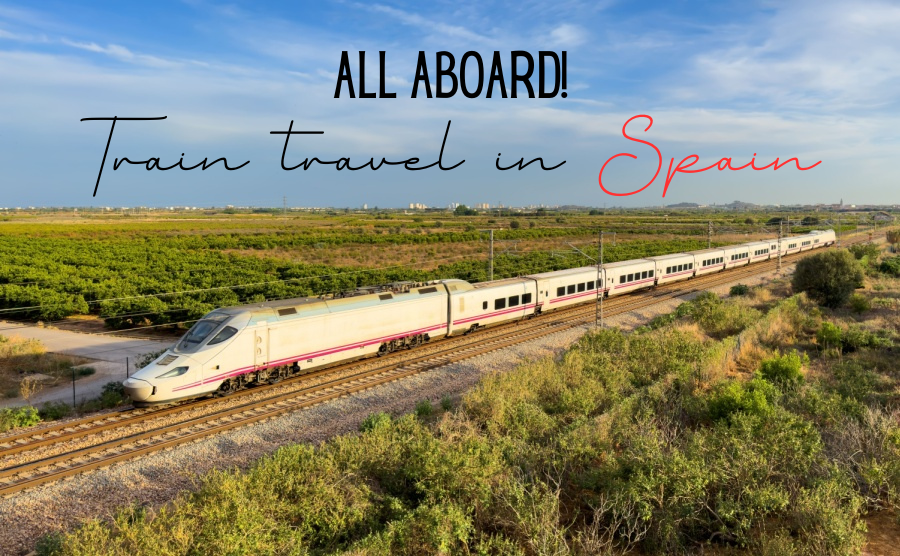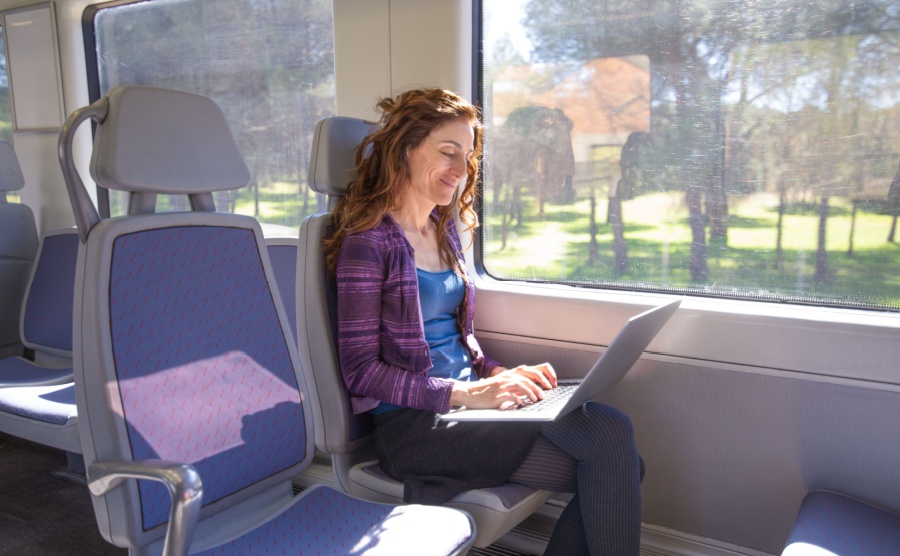All aboard the sustainability express! Kick back, relax, gaze out the window at the Spanish landscapes passing you by, and be pleased that you are choosing the more environmentally option to air travel. Sally, who has called Spain home for close to two decades, details what to expect from train travel in Spain. Discover the best links between major cities, commuter routes and luxury rides.
Find homes in Spain via our property portal.
Plane or train?
Various European governments have banned short haul flights within their countries if they take two hours or less in order to encourage more environmentally friendly travel, in particular using trains.
According to Ecopassenger, taking the train is always kinder to the environment and as an example a flight from London to Madrid will rack up 118 kg of CO2 emissions whilst the journey by train will emit just 43 kg.
Apart from the obvious benefit of travelling by train, there is also the question of convenience. Trains will get you close to a city centre, you don’t have to get to the station two to three hours before departure time (usually 30 minutes is fine). You don’t have to deal with the faff of baggage restrictions and you can pack liquids above 100mls to your heart’s desire. Plus, the experience is more leisurely too: your ears don’t pop, you can get up and walk about easily. Best of all, you can enjoy Spain’s wonderful ever-changing scenery as you speed along.
Spain’s trains: high speed, extensive
Spain has the second largest high speed train network in the world and is number one in Europe with 3762 km and trains running at up to 212 km an hour with excellent service on board.
Local train services are cheaper and slower but are generally on time and for regular users, many trains are free or very inexpensive.
The towns of Marbella and Málaga are just 60 km apart but as yet, there is no direct train service between them. There is, however, a train as far as Fuengirola. A regular train service has been discussed for 20 years or more but it seems that this busy area by the coast will not get a service for the foreseeable future. Overall though, most major towns and cities are well connected and train travel is the best way to find your way around Spain.
There are several different companies operating, so let’s see what’s on offer:
Renfe Ave, Avlo
Renfe was until a few years ago, the sole train operator in Spain. This all changed when the government allowed competition to enter the rail scene and now there are three main players. Nevertheless Renfe’s AVE (Spanish word for bird) is the gold standard of high speed trains, known for comfort and punctuality. The experience in First Class is similar to Business Class on flights and Economy class is considerably more comfortable than most Economy cabins on planes. It is the most expensive option but given that you will be passing by quaint villages, hills, rivers and ancient buildings in comfy style, it is the most enjoyable way to travel.
THe Avlo is Renfe’s budget fast speed service. The trains offer a no frills service on many of the AVE’s routes and is therefore an economical way to get from A to B. Journeys from Madrid to Barcelona take under 3 hours on both services and just 2.5 hours from Madrid to Málaga.
Renfe offers various types of card which will get you cheaper fares. For people over 60, there is the Targeta Dorada (gold card) which costs around €6 a year and offers up to 40% discount on some journeys and 25% on most.
Ouigo
One of the new operators is Ouigo, a French company owned by the French railway service SNCF. The trains, like the AVE and Avlo are sleek and modern but the fares are considerably cheaper. There is no First Class and seats are closer together but still have more legroom than a budget airline. These trains are also punctual and offer seven connections between major cities including Madrid, Barcelona and Alicante.
Iryo
Iryo is the newest train operator in Spain. It is a company formed by the Italian company, Trenitalia, Spanish Air Nostrum and Globalvia, a Spanish investment company. It is also a budget train service connecting nine major cities. You can book a meal ahead of travel which will be served to you at your seat. The trains are virtually silent, eco-friendly and the prices are very competitive.
Your regional train journey
These are part of Renfe’s network and there include the Avant trains which are high speed mid distance trains and Media Distancia, which are slower mid distance trains. These are not as plush or comfortable as the long-distance high-speed trains but are punctual and less expensive. Renfe’s discount cards also apply to these trains.
The daily grind: commuter train travel
Cercanías are Renfe’s commuter trains which run regularly in the major cities and their suburbs. These are usually pretty basic trains, designed to carry large numbers of passengers. If you have tickets on the AVE, journeys on Cercanías in your arrival city are free.
Travelling in style: Luxury trains
For people who want to experience a different kind of train travel, there are special trains to enjoy. The Al Alandus train transports you back to the 1920s, with its elegant carriages and upmarket dining experience. The train passes through historic places, olive groves and Moorish palaces.
The path less travelled: Transcantábrico
The Transcantábrico train will introduce you to some of the most beautiful and less well known areas of Spain, winding its way along the north west coast from Galicia to the Basque Country. The luxury here are the stunning views of green mountains, rugged coastlines and traditional fishing villages. The train itself is also luxurious, offering comfortable cabins and regional cuisine.
Eco-friendly and sustainable
Spain wants its rail network to be fast, convenient and environmentally friendly. A large part of the network is electrified, reducing the need for diesel and also reducing CO2 emissions. The newer hybrid trains can run on electrified and non electrified tracks and are being introduced and will become more common in the future. So, whether you are travelling for business or pleasure, you can enjoy the best of train travel in the knowledge that you have chosen the most sustainable form of transport.
You might also like:














